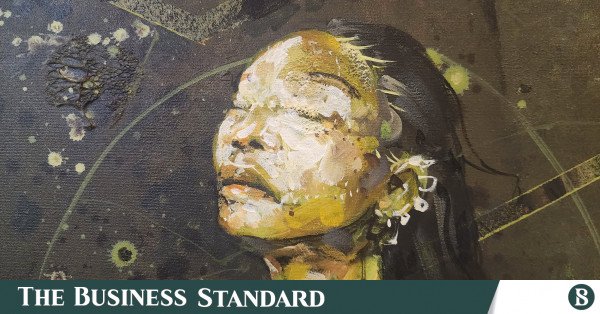“Expression leads to transformation,” is what Shazia Omar, founder and CEO of Dhaka Flow, asked the audience to remember when admiring the artworks.
‘Transformation: The Art of Alchemy’ is a painting exhibition curated by Dhaka Flow, taking place in July at the Gallery Residence of the Embassy of the Netherlands.
The exhibition brought together Bangladeshi artists, including Asma Akbar, Rokeya Sultana, Vinita Karim, Abdus Shakoor, Ranjit Das, Biplob Chakroborty, and Prashanta Karmakar Buddha.
Raeesa Selim, one of the curators, said that the exhibition is about “Transformation in its many forms; an evolution, as a metamorphosis, as a symbiosis, as alchemy, or however it comes to the audience.”
From Biplob Chakraborty’s delicate watercolours on paper to Vinita Karim’s intricate gold, copper, embroidery, and acrylics on linen, the exhibition’s vividly dynamic textures, styles, and visual experiences made it stay true to its name.
Palette, style, and theme; every artwork painted a different facet of what transformation really is.
Asma Akbar’s vibrant hues shift away from and into each other, mirroring the shifting of the human soul as they weave through the never-ending hurdles of memory, sorrow, and beauty.
Prashanta Karmakar’s Budhha captures humanity in the art of simply being human, capturing quiet moments to represent the subtle transformations that come with simply existing, gently reminding us that to be human is to be in constant motion.
In a world where it is easier to lose yourself amongst paint and canvases than to be fully present, this exhibition proved itself to be different. Jazz spilling out of speakers, drinks in hands, and food spread out, conversation filled the air at the Gallery Residence. It was a striking reminder that art is human, and to be human is to transform.
Rather than diminish the artists and their hard work by silently gazing at paintings under harsh lighting, Transformation did exactly the opposite. Warm lighting quietly enveloped the paintings without ever becoming too harsh on the eyes, casting moving shadows on the floor of the gallery as people talked, mingled, and enjoyed themselves.
It was a chance to be as alive and utterly transformed as the theme of the exhibition.
Shazia Omar, in her speech, said, “Art is shaped to the unspeakable,” upon which she reflected on the ever-shifting socio-political landscape of Bangladesh and the world. In a world where so much is happening all at once, expressing ourselves often escapes spoken word.
Sometimes, the unspeakable is easier to speak of when it’s between the brushstrokes of paintings and lines of poetry.
To transform– or to be transformed– can come in many ways. It can be in the quiet chaos of safe spaces where our human souls are transformed, as Ranjit Das’ women in their environment and Vinita Kabir’s escape into imaginary worlds.
It can be in the way clay can be shaped, changed, transformed by an artist’s hands, like so many things in this world are. Blending our rich culture that is ever transforming, yet ever familiar with the current world, Transformation captures, in its essence, the magic of alchemy.
‘Transformation’ and ‘alchemy’ are, at their core, synonymous. But are they? Alchemy suggests something intrinsically whimsical, magical, and fantastical. More literally, this can mean Abdus Shakoor’s mythological figures captured in brilliant colours. Going into the nuances of metaphors, Biplob Chakroborty’s ‘Rural Woman’, face half shrouded by mysterious leaves, reflects the transformation of the self.
Transformation does something special. Alchemy is not one specific subject; not one woman, or object, or place. It is everything.
There are complex layers of meaning to dissect when talking about how the exhibition portrays alchemy. There is alchemy as the concept of creation; how a blank canvas and tubes of paint can turn into a beautiful painting.
There is the alchemy of the soul, as was captured by the artworks; how time and memory and emotions meld together and split from each other to create individual human souls. There is the alchemy of the sacred self, of how exploration and discovery lead to the graceful yet thunderous transformation of ourselves.
Alchemy is innately, inevitably magical– and by showing us that everything is alchemy, ‘Transformation: The Art of Alchemy’ rediscovers that everything truly is magical.
TBS Picks
1. Speckled Dreams by Asma Akbar
Medium: Acrylic on Canvas
It is an abstract piece of bright reds, oranges and yellows, speckled with blues and browns. They melt into each other in chaotic yet defined movement, capturing the transformation in the emotions we feel through our dreams.
2. New Creations by Prashana Karmakar Budda
Medium: Acrylic on canvas
It shows a potter creating something out of clay, captured as if it’s on film. The layers of creation, from making pottery to taking pictures, represent the metamorphosis of the art and the artist through the process of creation.
3. Earth, Water, Air by Rokeya Sultana
Medium: Mixed Media on Canvas
The painting captures the sacred feminine as mirrored by Mother Nature in abstracted soft greens and yellows.


